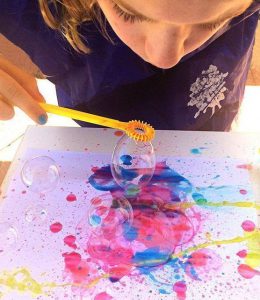Bubble Painting
You’ll need:
- Bubble mixture – a commercial mix from a bubble blowing set will work but we’re sure this would also work with a good quality DIY mix
- Food coloring
- Bubble wands
- Cups and/or trays to dip your wands into
- Large sheets of painting paper
Simply tip a little bubble mixture into each tray or cup – one for each color, and then add a little food coloring to each tray and stir gently – you don’t want to make too many bubbles in your cup because bubbles don’t work so well when the mixture is all bubbly. Then it’s time to blow bubbles all over your paper.
This is a great summer activity to take outdoors (trust us, you’ll want to do this outside or you will probably end up with popped bubble marks all over your walls)! Kids can work on exploring process art as each work will be different and experiment with colors!
Tip 1**Try asking children to predict what colors they can create when they blow two different colored bubbles on the same spot of their paper!
Tip 2**Work on breath control by asking children to blow gently and harder. See what happens to the bubbles when different breath strengths are used!
For more summer activities join us for Summertime Activities on June 6 from 6:30pm-8:30pm. This class is eligible for our BOGO deal*!
*BOGO= Buy One Class, Get One Class Free all summer! Your free class must be taken by August 31, 2017. Call 301-290-0040 to register!
To see all of our classes eligible for BOGO, Click here!


